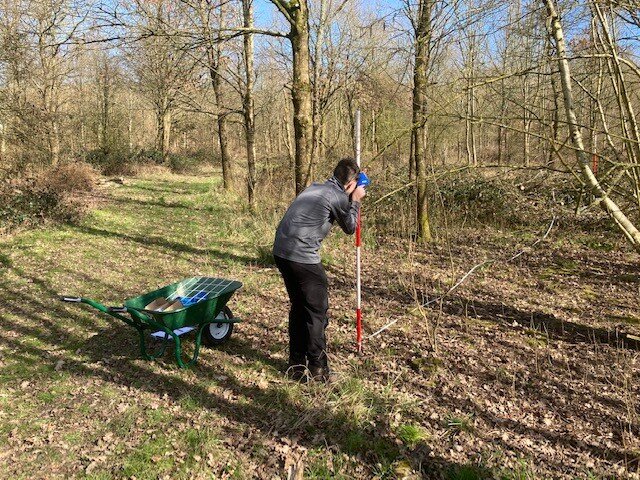Science:
In mid-winter, ecologist Gareth Harris took barn owl pellets home (sourced from the barn owl barn) and gently prized them apart to reveal their secrets. His findings & words from 10 pellets dissected:
Wood Mouse/Yellow-necked Mouse – 4 skulls and 4 pairs of low mandibles (in different pellets so likely 8 animals…..)
Field Vole – 7 skulls plus another 2 pairs of lower mandibles…..
Common shrew – 2 and possibly a third skulls
Pygmy shrew – possible skull, tiny but could be a young common shrew, hard to be sure….
A decent range of small mammals from UWNR and the surrounding land. The end of February proved challenging for barn owls (at UWNR and elsewhere), with lots of sightings of them hunting during the day. This can be a sign that they are under pressure to source suitable prey. I am not sure that the pair at UWNR survived - I last saw them sitting side by side on a hunting perch early one morning in late January 2021. They looked so sweet all loved-up & cuddling! The breeding season should reveal more…..
**********
At about the same time Gareth put out a bat detector on the land to gauge winter activity. In his words ‘Moderate levels of bat activity…’. These species were detected:
Whiskered bat
Brown long-eared bat
Common Pipistrelle
Soprano Pipistrelle
I was talking to him about winter activity and just loved this insight…younger bats tend to break their winter torpor more frequently than older bats. Those with greater experience winter roost in places which are warmer, drier and generally more suitable. This enables them to hunker down for longer stretches and use reserves more conservatively. Evidence shows that young bats are forced to feed more frequently to top up their reserves.
**********
Toads!
One night last week Gareth surveyed the lake at UWNR for amphibians - a cut / paste of his mail:
118 male toads plus 6 copulating pairs (spawn evident in a few places too)
25+ clumps of frog spawn
1 female smooth newt.
Spawning activity was also pretty low, so perhaps low temperatures were the reason for this.
Last year at about the same time, I stopped counting when I got to 130 floating, blinking faces peering back at a head-torched me…..so the population has sustained over the course of the last 12 months.
The day before Gareth visited, I discovered this slightly macabre collection of dismembered toads at the eastern end of the lake:
Much email chat about who the predator was and a big cast-list of suspects - raven, weasel, brown rat, otter, moorhen, mink, crow, badger and fox. On closer inspection I discovered more kills at various locations on the lake bank and this strange small midden of cleaned bones. We think the bones were likely cleaned by small mammals, after predation had occurred.
I will position the trail camera this week at the lake edge and see if we can discover who the predator is….
Spring is a time of surplus protein and this is evidence of a dynamic ecosystem functioning as it should….UWNR is working!
A huge thank you to Gareth for all this survey work and fascinating results!
**********
I have just read this extraordinary book for the second time….why isn’t this read at GCSE or A level I wonder.
It is jam packed with information about the state of our planet and a brilliant manifesto about how we could arrest the decline of many species. An issue which is mostly lost with Climate Change occupying centre ground…..
A fact that sticks - there are 2 million known species i.e. they have been identified, there are 7 - 8 million probable species in total on our planet, yet only 1000 have been intensively researched. With current extinction rates running at between 100-1000 greater than normal, think about these numbers…. Hugely recommended read.
**********
Throughout 2019, as part of the John Muir Award, we did an iGCSE in Environmental Studies. Nor pushed on and in 2020 sat her exam. SHE FLEW THROUGH! CONGRATULATIONS!
**********
Harry and Alex:
Both these wonderful young ecologists, (Harry doing his undergrad degree in Land Conservation & Ecology and Alex finishing his A-levels before he too goes to university to study ecology), are doing projects at UWNR. I helped Alex a couple of weeks ago with his project looking at soil type, species of flora and ambient conditions….Alex doing the science and me pushing the barrow around!
This summer Harry will do the field work for his 3rd year dissertation. He is going to research invertebrate species numbers in the areas which have been conservation hedge laid, and compare these data to areas which haven’t been laid (managed). Really looking forward to the results from this work. Again me on barrow….
**********
Springy things:
This time of the year is always transfixing - the days lengthen, temperatures increase and stuff begins to happen at a pace…..I was at UWNR on Monday and the lake was littered with birds – 6 tufted ducks , 2 little grebes, a heron, 4 mallard and 2 moorhens! An avian conference!
Caught this image of a resident moorhen some distance from the lake….poking about…love her colours.
It appears the roe deer has expelled last year’s juvenile from the territory in preparation to give birth to another fawn(s).
The wild honeybees are frantic already, returning to their log hives festooned in vibrant yellow pollen.
There are times in late January when the land feels locked in a weird stasis - from now on the opposite is true as it begins to hum then scream with life. Roll on…..
And the most endearing of all things….a huge (I am talking Muntjac size) female hare overseeing 3 / 4 leverets, they all ambling around the woodland at UWNR in a bit of a daze.




